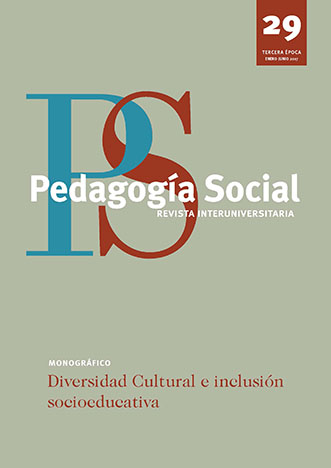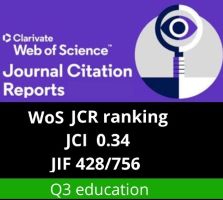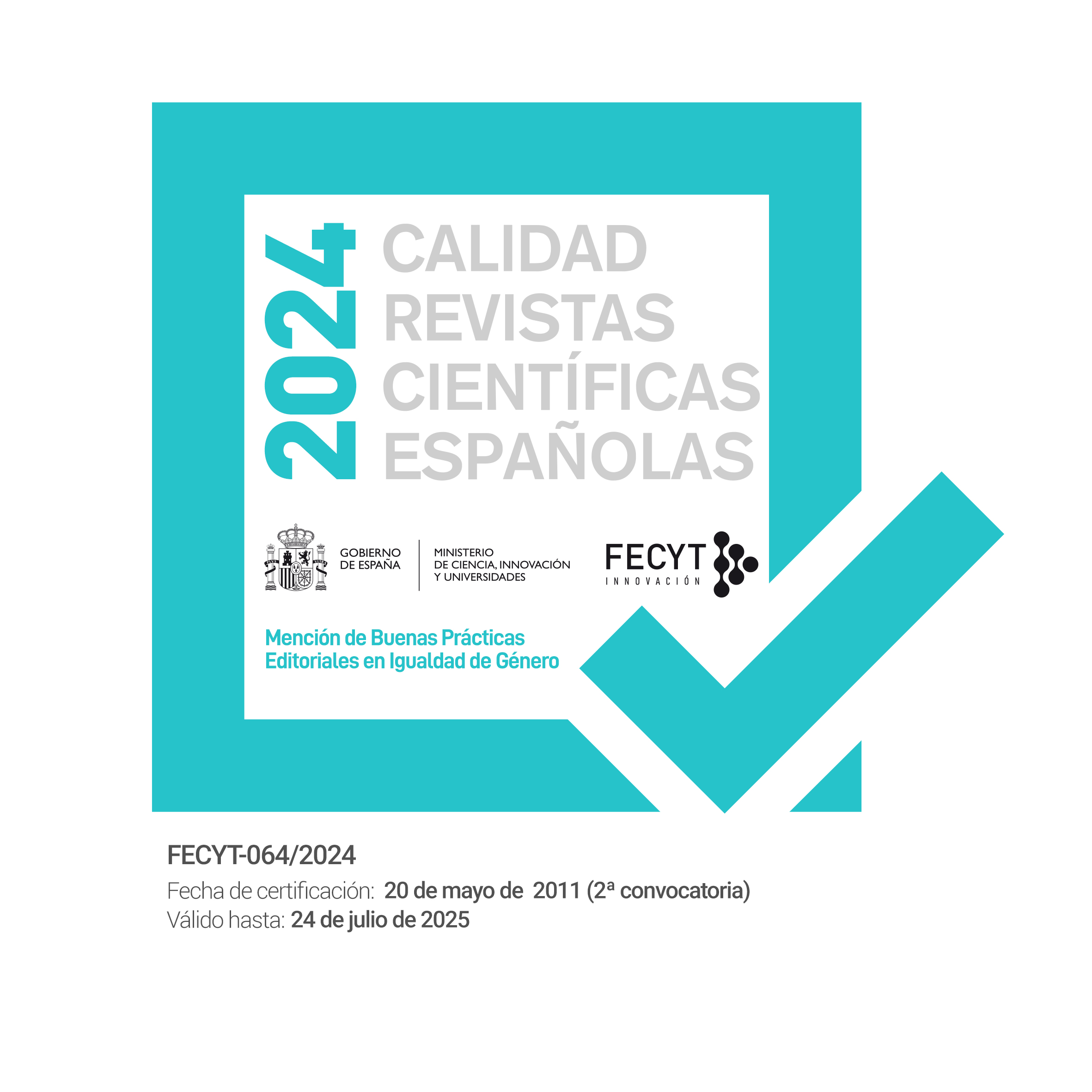La tecnología como inclusión educativa de la diversidad cultural: transformando prácticas informales de educación en los Estados Unidos
DOI:
https://doi.org/10.7179/PSRI_2017.29.04Palabras clave:
auto-narrativas digitales, cuento digital, BTCs, clase mágica, pedagogía narrativa, alfabetización digitalResumen
Este estudio analiza el impacto del uso de tecnología digital para reforzar los logros académicos de niños marginados exponiéndolos a determinados avances tecnológicos. Se analiza el uso de auto-narrativas digitales como pedagogía de transformación social, concretamente el impacto de la Clase Mágica (LCM) en un Centro escolar de Tejas (EEUU), con una alta población estudiantil de hispanos. La Clase Mágica es un proyecto extraescolar basado en la tecnología, diseñado para fomentar el logro académico de los estudiantes bilingües latinos que asisten a escuelas primarias, en particular en las áreas de bilingüismo, lectoescritura bilingüe y tecnología. En la experiencia participaron 20 Candidatos a Maestros Bilingües (Bilingual Teacher Candidate, BTCs ) quienes establecieron una relación con otros tantos alumnos de primaria, constituyéndose parejas de adulto-niño que se denominaron amigo/as y amiguitos/as. A lo largo de un periodo de 18 meses se aplicó una metodología cualitativa para la recogida y análisis de los datos, basada en auto-narrativas digitales, apuntes digitales de campo y transcripciones de las discusiones en las clases, para identificar temas, patrones y relaciones destacados, así como el tipo de tecnología utilizada. Los hallazgos de la investigación indican una necesidad por parte de los futuros maestros de involucrarse en un aprendizaje mediado por la tecnología con el fin de desarrollar un entendimiento práctico sobre la integración de la tecnología. Los resultados de esta investigación ofrecen un entendimiento adicional acerca de la dirección que deben tomar los programas de formación de maestros para servir mejor a los candidatos a maestros bilingües en su experiencia educativa con el fin de convertirse en maestros tecnológicamente competentes y preparados para cumplir con las necesidades de una población escolar lingüística y culturalmente diversa.
Descargas
Citas
References
Alanís, I. (2014). Preparing aspirantes: Synchronizing culture and digital media. In B. B. Flores, O. Vásquez & E. Riojas Clark (Eds.). Generating Transworld Pedagogy: Reimagining La Clase Mágica. Lexington Publishers, Rowman Littlefield Publishing Group.
Alanís, I., Machado-Casas, M., & Ruiz, E. (2014). Beyond the technical aparatus: Identity, connections, and the use of “Autonarrativas virtuales” Virtual Autonarratives. NABE Journal for Research and Practice 5. Accessed at https://www2.nau.edu/nabej- p/ojs/index.php/njrp/article/view/22/30
Andrews, M., Squire, C., & Tambokou, M. (Eds.) (2008). Doing narrative research. London: Sage.
Ben-Jacob, M., Levin, D., & Ben-Jacob, T. (2000). The learning environment of the 21st century. AACE Journal 1(13), 8-12.
Benmayor, R. (2008). Digital storytelling as a signature pedagogy for the new humanities, Arts and Humanities in Higher Education, 7(2), 188-204.
Brewer J. R. (2006). Narrative research and the challenge of accumulating knowledge. Narrative Inquiry, 16(1), 3-10.
Brewer, S. & Klein, J. D. (2006). Type of positive interdependence and affiliation motive in an asynchronous, collaborative leaning environment. Educational Technology Research and Development 54 (4), 331–354.
Buckingham, D. (2006). Is there a digital generation? In D. Buckingham and R. Willett (Eds.), Digital generations: Children, young people, and new media (pp. 1–13), Mahwah, New Jersey: Lawrence Erlbaum.
Bullock, D. (2004). Moving from theory to practice: An examination of the factors that preservice teachers encounter as they attempt to gain experience teaching with technology during field placement experiences. Journal of Technology and Teacher Education, 12(2), 211–237.
Chapelle, C. (2005). Hints about CALL use from research. PacCALL Journal, 1(1), 1-8.
Chen, R. -J. (2010). Investigating models for preservice teachers’ use of technology to support student-centered learning. Computers and Education 55, 32-42.
Clarke, M. (2009). The ethico-politics of teacher identity. Educational Philosophy and Theory, 41(2), 185-200.
Crouch, R. (2012). The United States of education: The changing demographics of the United States and their schools. Center for Public Education. Retrieved from http://www.centerforpubliceducation.org/You-May-Also-Be-Interested-In-landing-page-level/Organizing-a-School-YMABI/The-United-States-of-education-The-changing-demographics-of-the-United-States-and-their-schools.html.
Darder, A. (1991). Culture and power in the classroom: A critical foundation for bicultural education. New York: Bergin & Garvey.
Darder, A. (1995). Bicultural identity and the development of voice. In J. Frederickson (Ed.), Reclaiming our voices: Bilingual education, critical pedagogy and praxis (pp. 35–52). Ontario: California Association for Bilingual Education.
Dexter, S., & Riedel, E. (2003). Why improving preservice teacher educational technology preparation must go beyond college’s walls. Journal of Teacher Education, 54(4), 334– 346.
Ek, L., Machado-Casas, M., Alanís, I., & Sánchez, P. (2010). Crossing cultural borders: La Clase Mágica as a university-school partnership. Journal of School Leadership 20(6), 820-849.
Emerson, R., Fretz, R., & Shaw, L. (1995). Writing ethnographic fieldnotes. Chicago: University of Chicago Press.
Franklin, C. (2007). Factors that influence elementary teachers use of computers. Journal of Technology and Teacher Education, 15(2), 267–293.
Gallego, M. & Vasquez, O. A. (XXXX) Praxis in dis-coordination. In Portes, P. and Salas, S. (Eds.) Vygotsky in the 21st Century: Cultural historical theory and research in non-dominant communities. New York: Peter Lang Publishing.
Gordon, D.T. (Ed.). (2000). The digital classroom: How technology is changing the way we teach and learn. Cambridge, MA: The Harvard Education Letter.
Gorski, P. (2003). Privilege and repression in the digital era: Rethinking the sociopolitics of the digital divide. Race, Gender, & Class 10 (4), 145-176.
Grant, C. A., & Sleeter, C. E. (2011). Doing multicultural education for achievement and equity (2nd ed.). New York, NY: Routeledge.
Hammerness, K., Darling-Hammond, L., Barnsford, J., Berliner, D., Cochran-Smith, M.,
McDonald, M., et al. (2005). How teachers learn and develop. In L. Darling-Hammond & J. Bransford (Eds.), Preparing teachers for a changing world: What teachers should learn and be able to do (pp. 358-389). San Francisco: Jossey-Bass.
Knobel, M., & Lankshear, C. (1999). Ways of knowing: Researching literacy. Newton, Australia:
Primary English Teachers’ Association.
Lee, R. (2006). Effective learning outcomes of ESL elementary and secondary school students utilizing educational technology infused with constructivist pedagogy. International Journal of Instructional Media, 33, 87-93.
Machado-Casas, M. (2009). “Coyotes” tecnológicos: Sobrevivencia Transnacional de Comunidades Indígenas Latinas en los Estados Unidos. DIDAC, 53.Universidad IberoAmericana, México.
Marsland, N.,Wilson, I., Abeyasekera, S., & Kleth, U. (1999). A methodological framework for
combining quantitative and qualitative survey methods. Reading, UK: Social and Economic Development Department, Natural Resources Institute and the Statistical Services Centre, University of Reading.
Mather , M., & Foxen, P. (2010). America's future: Latino child well-being in numbers and trends. National Council of La Raza, 1. Retrieved from http://www.americaspromise.org/~/media/Files/Resources/NCLR- Americas Future.ashx
Mossberger, K., Tolbert, C., & Stansbury, M. (2003). Virtual inequality: Beyond the digital
divide. Washington, D.C.: Georgetown University. Press.
Nieto, S. & Bode, P. (2011). Affirming diversity: The sociopolitical context of multicultural education (6th Ed.). New York: Pearson Education.
Prensky, M. (2001). Digital natives, digital immigrants. On the Horizon, 9 (5), np.
Rico, R. J., Sánchez, P., Pallares-Weissling, A. (2012). A snapshot of Latina/o bilingual teacher candidates and their use of iPads in an after-school technology program. Journal of Bilingual Education Research & Instruction, 14(1), 95-115.
Russell, M., Bebell, D., O’Dwyer, L., & O’Connor, K. (2003). Examining teacher technology use: Implications for preservice and inservice teacher preparation. Journal of Teacher Education, 54(4), 297–310.
Sánchez, P. & Salazar, M. (2012). Transnational computer use in urban Latino immigrant communities: Implications for schooling. Urban Education. 47(1), 90-116.
Schlager, M. S. & Fusco, J. (2006). Teacher Professional Development, Technology, and
Communities of Practice: Are We Putting the Cart Before the Horse?. The Information Society: An International Journal. 19(3), 203-220.
Schrum, L. (1999). Technology professional development for teachers. Educational Technology Research and Development, 47(4), 83–90.
Schellens, T., Van Keer, H., & Valcke, M. (2005). The impact of role assignment on knowledge constructionin asynchronous discussion groups: A multilevel analysis. Small Group Research, 36, 704-745.
Vásquez, O. A. (2003). La Clase Mágica: Imagining optimal possibilities in a bilingual community of learners. New Jersey: Lawrence Erlbaum Associates, Inc.
Vásquez, O. A. (2008a). Reflection: Rules of engagement for achieving educational futures. In L. L. Parker (Ed.), Technology-mediated learning environments for young English learners: Connections in and out of school. New York, NY: Taylor & Francis Group.
Vásquez, O. A. (2008b). “Technology out of school: What schools can learn form community-based technology.” In L. Smolin, K. Lawless, & N. C. Burbules (Eds.). The 106 yearbook of the National Society for the Study of Education: Information and Communication Technologies: Considerations of Current Practice for Teachers and Teacher Educators, 106, 182-206.
Vygotsky, L.S. (1978). Mind in society. Cambridge, MA: Harvard University Press.
Zevenbergen, R. (2007). Digital natives come to preschool: implications for early childhood practice. Contemporary Issues in Early Childhood 8(1), 19-29. http://dx.doi.org/10.2304/ciec.2007.8.1.19
Descargas
Archivos adicionales
Publicado
Cómo citar
Número
Sección
Licencia
Derechos de autor 2016 Pedagogía Social. Revista Interuniversitaria

Esta obra está bajo una licencia internacional Creative Commons Atribución-NoComercial-CompartirIgual 4.0.
Derechos de reproducción y archivo
La versión publicada de los artículos podrá ser autoarchivada por sus autores en repositorios institucionales y temáticos de acceso abierto. No obstante la reutilización total o parcial de los mismos en nuevos trabajos o publicaciones deberá ser autorizada por Pedagogía Social. Revista Interuniversitaria.
Los trabajos publicados deberán ser citados incluyendo el título de la Revista, Pedagogía Social. Revista Interuniversitaria, nº, páginas y año de publicación.
Responsabilidades éticas
Pedagogía Social. Revista Interuniversitaria no acepta material publicado anteriormente en otros documentos. Los/as autores/as son responsables de obtener los permisos oportunos para reproducir parcialmente material de otras publicaciones y citar correctamente su procedencia. Estos permisos deben solicitarse tanto al autor/a como a la editorial que ha publicado dicho material.
Es obligación de Pedagogía Social. Revista Interuniversitaria detectar y denunciar prácticas fraudulentas.
En la lista de autores/as firmantes deben figurar únicamente aquellas personas que han contribuido intelectualmente al desarrollo del trabajo.
La revista espera que los/as autores/as declaren cualquier asociación comercial que pueda suponer un conflicto de intereses en conexión con el artículo remitido.
Los autores deben mencionar en el manuscrito, preferentemente en el apartado del método, que los procedimientos utilizados en los muestreos y controles han sido realizados tras la obtención de consentimiento informado.
La revista no utilizará ninguno de los trabajos recibidos con otro fin que no sea el de los objetivos descritos en estas normas.
Aviso de derechos de autor/a
© Pedagogía Social. Revista Interuniversitaria. Los originales publicados en las ediciones impresa y electrónica de esta Revista son propiedad del Pedagogía Social. Revista Interuniversitaria, siendo necesario citar la procedencia en cualquier reproducción parcial o total.
Salvo indicación contraria, todos los contenidos de la edición electrónica se distribuyen bajo una licencia de uso y distribución “Creative Commons Reconocimiento-No Comercial 3.0 España” (CC-by-nc). Puede consultar desde aquí la versión informativa y el texto legal de la licencia. Esta circunstancia ha de hacerse constar expresamente de esta forma cuando sea necesario.






